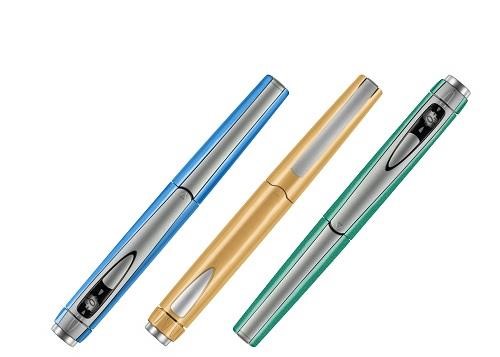By making drug-delivery devices (e.g. pens, inhalers, and the like) more unique and attractive to patients, manufacturers of these products hope to improve patient adherence to treatment.
When added to plastics, special effect pigments create a singular impression like pearlescence, sparkle or a metallic look. These materials have been used for many years to enhance the look and market appeal of personal care and consumer goods, where less regulatory documentation is required.
Several factors combine to increase the importance of using color creatively in the healthcare market, explains Steve Duckworth, who heads Clariant's healthcare polymer solutions. A speciality chemicals company, Clariant
launched a line of new special-effect colorants for personal medical devices earlier this year.
"Diseases such as COPD and diabetes are rapidly increasing, and self-administered medication, via auto injector or inhaler is becoming the norm. At the same time, U.S. studies indicate only 28% patient-adherence to treatment programs,"
says Duckworth. “The cost of wasted medication and follow-on treatment is estimated in the billions of dollars and companies are looking for ways to make their devices more attractive and easier to use, creating standard 'device platforms' that can be customized with color and special effects."
COLORANTS PRIMER
According to BCC Research analyst Srinivasa Rajaram, colorants are chosen to work well over the life of the application. Pigments and dyes are added to plastics to match the right mix of colorants. The standard system for quantifying color is the L*a*b* color space devised by the Commission Internationale de l’Eclairage (CIELAB). This CIELAB system describes color in three dimensions as lightness, red-green and yellow-blue.
“The choice of a colorant depends on the final product, and the colorant must satisfy the requirement for brilliance, light, fastness, opacity or transparency. Colorants should be stable at molding temperatures and with exposure to light, moisture and oxygen,” Rajaram explains.
COLORANTS CLASSIFICATIONS
Colorants are classified as either pigments or dyes.
Pigments. Pigments are supplied in one of three manners: as a powder form, as a liquid mixed with a plasticizer or as color concentrates mixed with a base plastic material. Pigments must have the ability to be dispersed throughout the plastic. They may be inorganic or organic in nature and are finely ground, insoluble particles. Inorganic pigments include carbon black, titanium dioxide, iron oxide, lead chromates, mixed metal oxides, chromium oxide and ultramarines.
Organic pigments can be of classical and specialty grades. Workhorse yellow, orange and red pigments are classical grades. Quinacridone, disazo, perylene, benzimidazolone and phthalocyanine blues and greens are specialty grades and are generally more costly than classical grade pigments.
Dyes. Dyes are organic chemicals that dissolve in plastic to form strong, transparent colors. Anthraquinone and azo compounds are some of the dyes used, which are generally transparent; they only absorb light and do not scatter it. Dyes may not be as stable as pigments as they have a tendency to break down during processing.
Rajaram says that new color concentrates in aluminum, blue steel, brass, copper, gold and pewter formulations have been developed to add a luxurious metallic look to plastics used in the packaging of health and beauty products. Light-stabilized colorants based on light-stable pigments containing stabilizers that provide UV resistance have been developed in concentrated and dry-color formulations in shades of wood, earth and stone. Non-lead colorants, which are considered environment-friendly, have been developed for wire and cable applications.
COLORANTS USE IN MEDICAL DEVICES
"If this technology has been used successfully in consumer goods," Duckworth suggests, "why not in medical devices? We believe that, by making pens and other personal medical devices more like consumer products, patients may be more inclined to carry them and use them."
He notes that similar effects have been created using paint and other decorative processes, but these can lack durability, and can severely impact the cost of the plastic component. Special-effect pigments, on the other hand, are compounded into the plastic and cannot chip, scratch or peel off.
GLOBAL MARKETS FOR COLORANTS/PLASTICS ADDITIVES
Rajaram expects the global market for colorants to increase at a five-year (2016-2021) compound annual growth rate (CAGR) of 4.8%. Valued at more than $2 billion in 2014, the market should reach more than $2.8 billion in 2021. Of the various types of colorants used as plastics additives, soluble dyes are expected to increase at the highest rate of growth, he adds.
In 2015, the global market for plastics additives was valued at $48.2 billion. Rajaram estimates the market to grow from nearly $50.6 billion this year to $64.6 billion by 2021 reflecting a five-year CAGR of 5%.
Source:




